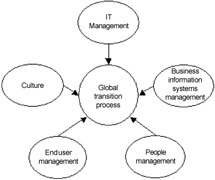Background
|
|
During the global transition, organizations often face many tacit as well as explicit factors that could delay or, in worst cases, even destroy the globalization process. In order to eliminate these unnecessary incidents, enterprises need to identify the possible issues that will impede the process of globalization before it takes place.
In the past decade, researchers have put in significant efforts in identifying the global information systems management (GISM) issues. Most notable are Senn's six key information technology issues (Senn, 1992), and the eight multinational categories of global information technology issues by Palvia and Saraswat (1992). In addition, a number of issues have been identified in various areas, including culture (Burn et al., 1993; Ein-Dor et al., 1993; Sauter, 1992; Yellen, 1997), human resource management (Agocs and Suttie, 1994; Boudreau et al., 1994; Harrison and Deans, 1994; Niederman, 1994; O'Connell, 1997; Pucik and Katz, 1986), individual country and region (Palvia et al., 1992; Watson et al., 1997), business strategic planning (Cheung and Burn, 1994; Ives et al., 1993; Gibson and McGuire, 1997; Kesner and Palmisano, 1996; Minor and Larkin, 1994; Neo, 1991; Sethi and Olson, 1992; Unhelkar, 1999), practical issues (Edberg et al., 2001), and technology (Klein, 1999; Passino and Severance, 1990; Sankar and Prabhakar, 1992; Waples and Norris, 1992).
Based on the implication of issues on the process of globalization, five categories are identified to facilitate classification and collation of the GISM issues. The core concept of categorization intends to provide the organizations an abstract overview of concerns in relation to the transition to globalization. These categories are labeled as:
-
Information technology management
-
Business information systems management
-
People management
-
End user management
-
Culture
The criteria of grouping and forming GISM categories are based on the intention and affiliated field of individual issue. Coincidentally, the first four categories match the emphasis of management IT issue categories developed by Khandelwal and Warrington (1999). Culture, the fifth category, is identified to ensure the completeness focus of cross-border and global information systems distribution and management. Figure 2 shows the overall schematic of transition issue categories and the global transition process. The following sections provide detailed study and explanation of each GISM issue category and the underlying issues in relation to global transition process.

Figure 2: Global information systems and transition issue categories
|
|
EAN: 2147483647
Pages: 224